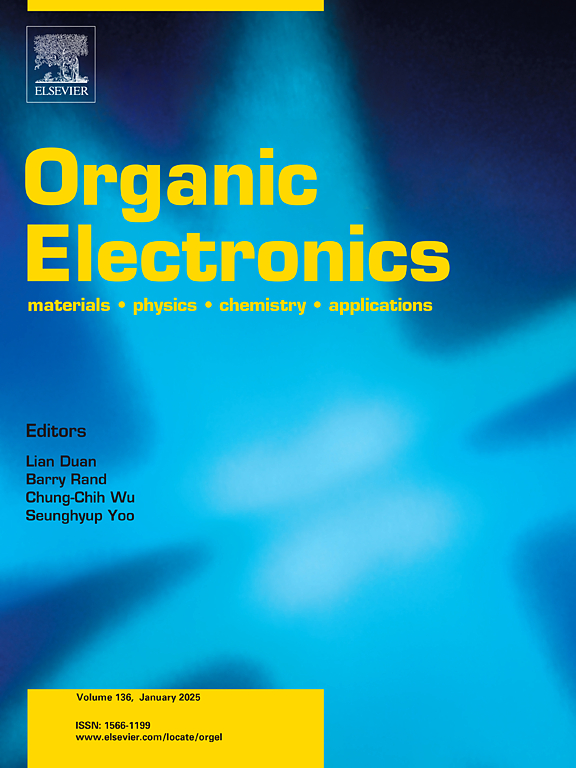磷光和TADF oled中氰基主体材料的主客体能级匹配标准
IF 2.6
4区 工程技术
Q3 MATERIALS SCIENCE, MULTIDISCIPLINARY
引用次数: 0
摘要
对于高性能oled来说,开发具有平衡双极输运特性和适合不同掺杂发射体的合适能级对准的通用宿主材料仍然是一个巨大的挑战。本研究通过在众所周知的空穴传输寄主mCBP(3,3 ' -二(9h -carbazol-9-基)-1,1 ' -联苯)中咔唑环的3位或4位引入氰基(CN),提出了3CN-mCBP和4CN-mCBP两种双极性寄主材料。与mCBP相比,修饰后的宿主表现出相当或略微降低的三重态能级,以及更深的HOMO和LUMO能级。电荷输运表征表明,4CN-mCBP >顺序的电子注入/输运增强;3CN-mCBP > mCBP,具有空穴输运能力的顺序相反:mCBP >;4 cn-mcbp比;3 cn-mcbp。在使用(ppy)2Ir(acac)的绿色磷光oled中,与mCBP(11.8%)相比,cn修饰的主机实现了更高的效率(21.6%和19.9% EQE),而使用FIrpic的蓝色器件则表现出相反的性能趋势。对于绿色TADF发射极4tCzDOXD,所有主机的效率相当(15.3 - 17.9%)。这些结果突出了为各种发射极系统开发通用宿主材料所面临的挑战。本文章由计算机程序翻译,如有差异,请以英文原文为准。

Host-guest energy level matching criteria for cyano-based host materials in phosphorescent and TADF OLEDs
The development of universal host materials with balanced bipolar transport properties and appropriate energy level alignment for diverse dopant emitters remains highly challenging for high-performance OLEDs. This study presents two bipolar host materials, 3CN-mCBP and 4CN-mCBP, by introducing cyano (CN) groups at the 3- or 4-positions of carbazole rings in the well-known hole-transport host mCBP (3,3′-di(9H-carbazol-9-yl)-1,1′-biphenyl). Compared to mCBP, the modified hosts exhibit comparable or slightly reduced triplet energy levels, along with deeper HOMO and LUMO energy levels. Charge transport characterization demonstrates enhanced electron injection/transport in the order of 4CN-mCBP > 3CN-mCBP ≫ mCBP, with hole transport capabilities following the reversed sequence: mCBP > 4CN-mCBP > 3CN-mCBP. In green phosphorescent OLEDs using (ppy)2Ir(acac), the CN-modified hosts achieve superior efficiencies (21.6 % and 19.9 % EQE) versus mCBP (11.8 %), while blue devices with FIrpic show opposite performance trends. For green TADF emitter 4tCzDOXD, all hosts yield comparable efficiencies (15.3–17.9 %). These results highlight the challenges in developing universal host materials for diverse emitter systems.
求助全文
通过发布文献求助,成功后即可免费获取论文全文。
去求助
来源期刊

Organic Electronics
工程技术-材料科学:综合
CiteScore
6.60
自引率
6.20%
发文量
238
审稿时长
44 days
期刊介绍:
Organic Electronics is a journal whose primary interdisciplinary focus is on materials and phenomena related to organic devices such as light emitting diodes, thin film transistors, photovoltaic cells, sensors, memories, etc.
Papers suitable for publication in this journal cover such topics as photoconductive and electronic properties of organic materials, thin film structures and characterization in the context of organic devices, charge and exciton transport, organic electronic and optoelectronic devices.
 求助内容:
求助内容: 应助结果提醒方式:
应助结果提醒方式:


